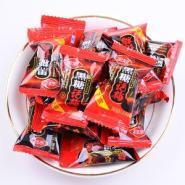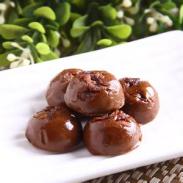The development of traditional Chinese foods and beverages to modern industrial products is one of the recurrent themes of this blog. Today I am thrilled to introduce the an innovation process that has already reached a third stage.
Traditional
Huamei, dried and preserved plums, has been a favourite snack of Chinese, in particular ladies, for ages. It refreshes the mouth and the mind. It can be taken after a meal to help digestion and to get rid of bad breath, after indulging on garlic. And after a sumptuous lunch it also gives the mind a boost that can keep your engine running, when it starts dozing off.
Huamei are also regarded as a traditional Chinese medicine (TCM) that is i.a. beneficial to the stomach, lungs or spleen.
The traditional huamei were basically dried and salted plums, scented with licorice and sometimes other ingredients like: lemon juice, aniseed, cloves or cinnamon. This was done for obvious reasons: preservation of the fruits in a relatively hot and humid climate. They were sold in dispensaries and shops specialising in dried and preserved fruits,
Huamei as ingredient
Huamei can also be used as an ingredient. It is e.g. the main ingredient in the traditional plum sauce, combined with garlic, chili, ginger, dried tangerine peel (chenpi), soy sauce, salt, rock sugar, and starch.
In cooking, the sweet & sour zest of huamei can complement the flavour of fatty meat, in particular duck or spareribs (see illustration). Here as well, it is often combined with dried tangerine peel.
Industrial
In the course of the 20th century, huamei were packed in glass jars and later in plastic bags, each plum wrapped in a special paper to retain the moisture.
People started eating them more like a snack, so huamei became part of that very Chinese food group called ‘leisure food‘.
These products were adapted to large scale industrial production. Several additives were used to stabalised the texture and the flavour for a longer period. Here is a standard recipe
| Ingredient | weight |
| Dried plums | 100 kg |
| Licorice | 2.5-3.0 kg |
| Salt | 3-5 kg |
| Sodium cyclamate | 2-3 kg |
| Citric acid | 1-2 kg |
| Potassium sorbate | 100 gr |
| Cinnamon/cloves/aniseed | 50 gr each |
Chinese plum processors have formed an association to jointly defend their interests in March 2019.
Innovative
Jinguan Food Co., Ltd. (Pujiang, Fujian) has developed a candy based on huamei, called Heitang Huamei, literally: ‘Black Sugar Huamei’. That English translation may not sound particularly appetising, but is probably derived from the dark colour of the product.
This candy gives a unique flavour sensation. The first impression is sweet and creamy, but as soon as the miniscule pieces of huamei are reached, the refreshingly sour taste of huamei emerges to counter the sweetness. It is still highly appreciated after a meal, or when you are starting to feel sleepy behind the wheel of your car.
The product’s label lists the following ingredients:
glucose syrup, white sugar, brown sugar, coconut fat, palm oil, condensed milk, huamei pieces, milk powder, cream, additives (phosphate, sucrose ester, caramel colour, salt, flavours.
While the first innovative step mainly addressed the adaptation of the traditional product to economic scale production, the second step was more innovative, using modern food technology to create a combination of flavours more complex that the traditional huamei.
Another innovative product is produced by Liuliu Orchard (Anhui): Coffee Plums. This product links a traditional Chinese snack to the currently emerging coffee culture.
This product might as well succeed in many overseas markets!
Peter Peverelli is active in and with China since 1975 and regularly travels to the remotest corners of that vast nation. He is a co-author of a major book introducing the cultural drivers behind China’s economic success.









Pingback: Medicine Food Same Source | Peverelli on Chinese food and culture
Pingback: Leisure food – A very Chinese food group | Peverelli on Chinese food and culture
You share interesting things here. I think that your website can go viral easily, but you must give
it initial boost and i know how to do it, just type in google (with quotes) for – “mundillo traffic increase make your website go viral”
Pingback: Candy in China – not only for the eyes | Peverelli on Chinese food and culture
Pingback: Traditional Chinese snack food | Peverelli on Chinese food and culture
Pingback: New milk ad reflects cultural change in China | Peverelli on Chinese food and culture
Dr. Peverelli,
My name is Marlen Sole and I have read your blog with great interest. I am from Germany, but I live with my husband in Hawaii where we run a small business. We buy chinese ingredients like Dried Lemon Peel and Li Hing Mui for our products.
I found your blog while researching Li Hing Mui and read with great interest about Huamei and its ingredients. I would like to ask you for advice. We could not find huamei free of additives, aspartame and food coloring. Do you know if there is any Huamei without additives and aspartame which is manufactured in Asia? I would be very thankful if you could point me in the right direction.
Sincerely yours,
Marlen Sole
Pingback: Together Forever (至此终年) — Chapter 8.2 | Fanatical
Pingback: The rise of China’s new coffee culture | Peverelli on Chinese food and culture
Pingback: Sour is the new sweet in China – young Chinese food scientists play with vinegar | Peverelli on Chinese food and culture
Pingback: PRESERVED WIFE PLUM | Never Pure and Rarely Simple
Pingback: Preserved fruit – possibly China’s the oldest candy | Peverelli on Chinese food and culture